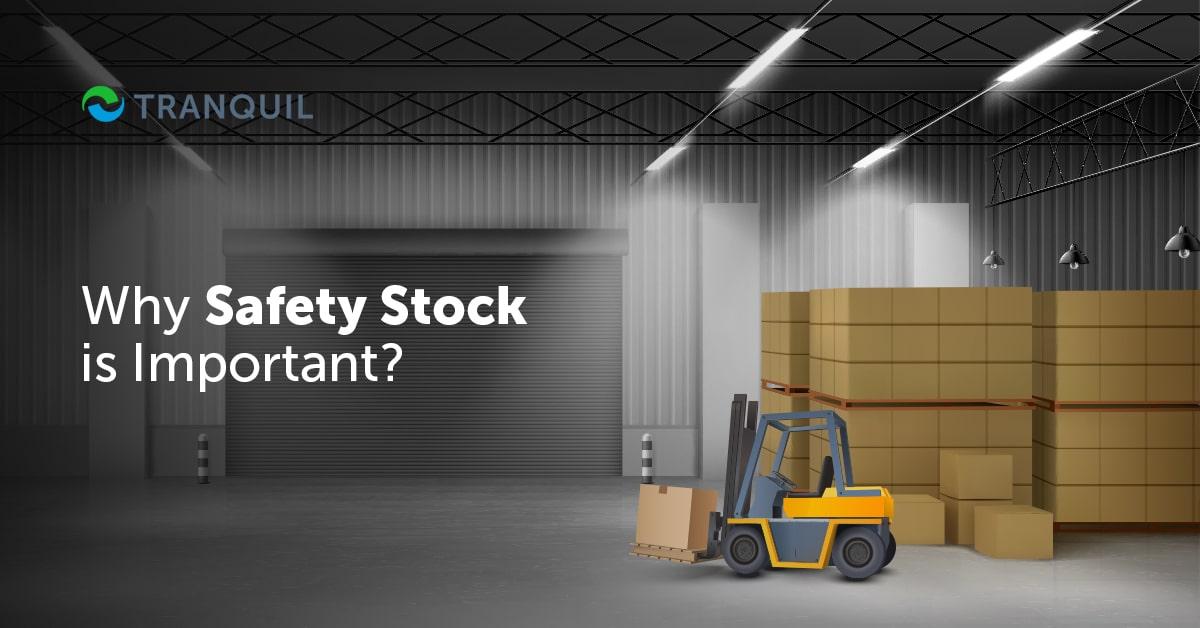
Any business that has to handle product inventory, like consumer goods, E-commerce, food, etc. is faced with the constant challenge of maintaining the right stock levels – neither too less nor in excess.
If a high-selling item gets stocked out frequently, consumers will get annoyed and take their business elsewhere.
Managers are aware that carrying too much excess inventory means incurring heavy expenses.
You need to strike a balance between being able to fulfil consumer demand and incurring minimal carrying costs.
Efficient inventory management is a critical requirement for any business that wants to be successful.
Maintaining safety stock is one method of inventory management that helps you have optimal stock with you.
ALSO READ: Why is Cycle Stock Important for Your Business?
Safety stock is the excess or buffer stock of an inventory item stored in the warehouse to avoid the situation of getting stocked out.
It helps to brace against demand fluctuation and guard against delays in receiving fresh supplies.
When you maintain a safety stock level, you won’t be caught short because of erratic supply or demand.

Safety stock inventory ensures that you don’t get stocked out; even if your vendors delay deliveries or you have unprecedented demand, you will have sufficient quantity in hand to meet the demands of production or sales.
ALSO READ: What is Inventory Reorder Point (ROP)?
In fact, it offers a host of advantages, like:
Market forecasts may go wrong, or due to any of several reasons, the demand for specific products may skyrocket.
When you have a safety stock of those items, you can keep producing or selling those items and meet customer demand.
Without the safety stock, you may have to turn customers away, or pause production.

You may have good suppliers who deliver your orders consistently every time within the promised time, so you may not have faced delays in delivery.
But several external factors may impact delivery, like the weather, machinery breakdown at the manufacturer’s, strikes, breakdown of vehicles, or anything else, which can cause your delivery to get delayed.
In such times, safety stock is your shield against possible stocked-out situations, helping you to fulfil demands till fresh stocks arrive.
ALSO READ: What is Storage Cost of Inventory?
It’s not only your business, but even your vendors who can get impacted by a disruption in the supply chain – unavailability of raw materials, disruption in transportation, natural disasters, failure in procurement, and other factors.
What all of this means for your business is that your lead time for getting delivery of the required products increases beyond the time you had factored in.
However, having adequate safety stock can help prevent disruption in your production or sales.
If products that are sold regularly keep getting stocked out, you are likely to face several annoyed customers; they may come back a couple of times, but if it happens too many times, they will most likely buy similar products from your competitors.
Additionally, they may also speak negatively about your brand.
ALSO READ: What is Pipeline Inventory and Decoupling Inventory?
Sudden fluctuations in market price can lead to the cost of your products to rise sharply.
Raw material scarcity, increase in price, regulations and government policies, market demand fluctuations, or other factors may lead to this situation.
Having adequate safety stock can help you overcome unpredictable and challenging situations.
In case you face a sudden shortage of products or raw materials, you may have to resort to urgent purchases from new vendors.
Urgent purchases tend to be more expensive; with safety stock, you will not need to shell out extra cash for your materials or goods.
That brings us to an important question: How much safety stock should you keep?
Every business is unique, with its own requirements and goals; it goes without saying that there is no one single rule for
the one-size-fits-all approach doesn’t apply to safety stock.
Based on various demand and supply factors, different products have different safety stock levels.
ALSO READ: Advantages of ABC Analysis in Inventory Management

It is imperative to know safety stock calculation so that you know how much stock to keep in hand; too much safety stock means increased carrying costs, and too little leads to lost sales.
With a proper formula, you can calculate the ideal safety stock for your company.
There are several different formulae for calculating safety stock, and they use different details and parameters.
However, knowing lead time – the time between placing the order and its receipt in your warehouse – is essential for almost all of them.
ALSO READ: What is Dead Stock – How Can You Avoid It?
Let us look at the different methods:
Production planners prefer the method of fixed safety stock.
They don’t use a specific formula, and the quantity remains fixed, till the production manager decides to alter it.
Now this fixed number could be anything – even 0 if the lead time is very short and the frequency of sales or rate of consumption of that item is not high.
However, you do run the risk of getting stocked out in unforeseen circumstances.
Depending on the forecast for a particular product, the safety stock is calculated over a specific time period.
Here, the predicted demand (calculated per statistics) and the actual demand as seen from sales or orders, are combined.
However, it is unable to predict uncertainties in business, so you run the risk of holding excess stock in case your sales are happening slower than your expectations.
ALSO READ: Common Inventory Management Problems and Solutions

This is the simplest and most commonly used method of safety stock calculation.
It calculates the average safety stock a business needs to carry to avoid stockouts.
However, this method also does not take seasonal demand fluctuations into consideration.
The safety stock is arrived at when you multiply the maximum daily usage of an item, or the maximum number of units sold in one day, by the maximum lead time; in other words, the longest time the vendor has taken to deliver your product, and then subtract the average daily usage of that product – which is the average number of units sold per day, and the mean lead time – or the average time the vendor needs to deliver your goods.
In other words, safety stock = (max units sold/used per day x maximum number of days needed by vendor) – (average number of units sold/used per day + average number of days taken by the vendor)
ALSO READ: Tips For Efficient Stocktaking
When the vendor’s lead time fluctuates significantly, this formula is the apt one.
It provides a precise picture about your lead time, and how often you have to handle late shipments, as it makes use of the standard deviation of lead time distribution.
This method also does not consider the fluctuations in demand for calculating safety stock.
Here, Safety stock = Desired service factor (Z score) x standard deviation in lead time.
Here, the standard deviation in lead time refers to the intensity and frequency by which the average lead time and actual differ from each other.
The desired service factor or Z score allows you to determine how sure you want to be about stocking sufficient inventory.
It is a value that you need to choose to avoid stockout.
The lower your Z score, the lower your chances of having a stocked-out situation.
ALSO READ: Physical Stock Verification and Its Advantages
This formula takes into consideration fluctuations in demand as well as lead time; therefore, it is considered a more precise method of safety stock calculation.
But this too has its drawbacks, as it does not consider work in progress – that is stock which is in production and not ready to be sold yet.
Here, Safety stock = average demand x desired service factor (Z score) x standard lead time deviation.
Safety stock is a company’s protection against unforeseen situations.
Accurate calculation of safety stock is critical if you want to ensure that you don’t get stocked out and lose sales.
You need to weigh all these methods and determine which one will best suit your business.
ALSO READ: What is Stock Adjustment and Stock Transfer?

Safety stock is not optional or decorative, but essential.
Here are the chief arguments in favour of businesses of all sizes keeping safety stock inventory.
ALSO READ: What is Zero Inventory?
In all of this it would do well to remember that safety stock does not have a one size fits all formula or approach.
The formula or method to calculate safety stock need to be dynamic and must be linked to the accuracy of forecast, variation in lead times, service levels, and so on.
In fact, within a company, you are likely to have hundreds or thousands of SKUs, each with unique demand and usage rates.
Therefore, you will need to have different safety stock levels for each item.
Mere rule-based approaches are not very reliable for calculating optimal inventory levels; you need a sound mathematical approach.
Only then will you be able to balance the opposite goals of reducing expenses and increasing quality of customer service.
Calculating safety stock levels for hundreds, or even dozens of products can be cumbersome and monotonous.
However, you can implement a robust ERP like Tranquil which will automate this and other inventory management processes. This will help save a lot of time, effort, and money for your business.
If you are not sure how our software can benefit your business, do schedule a demo at a data and time of your choosing, and we will be happy to walk you through it. Our executives will be on hand to answer any queries you may have regarding the ERP solution.